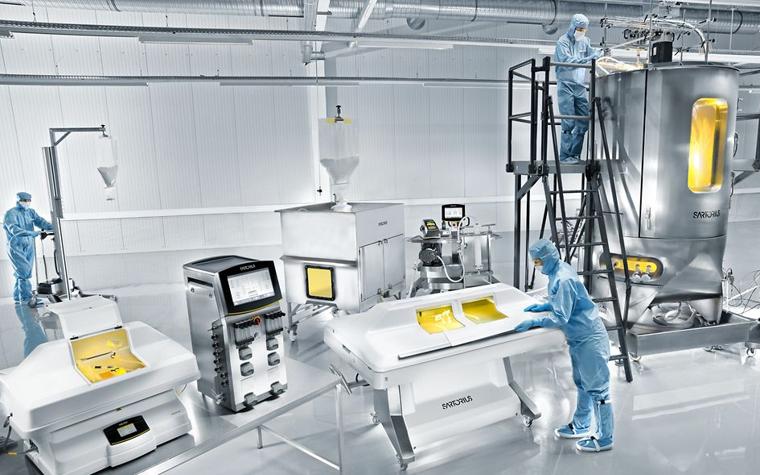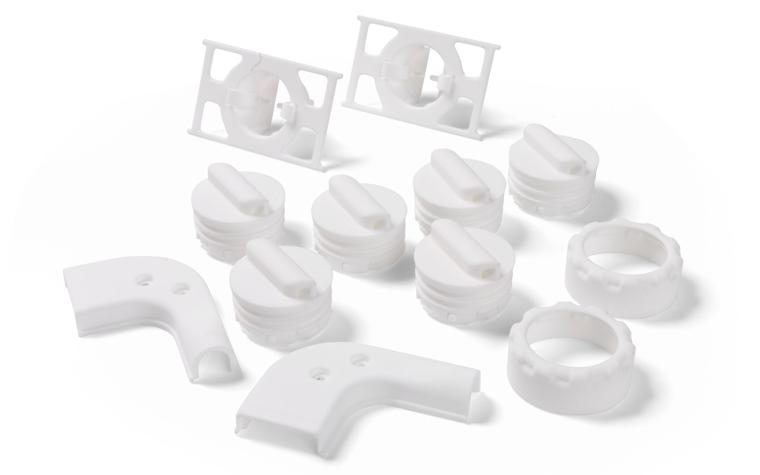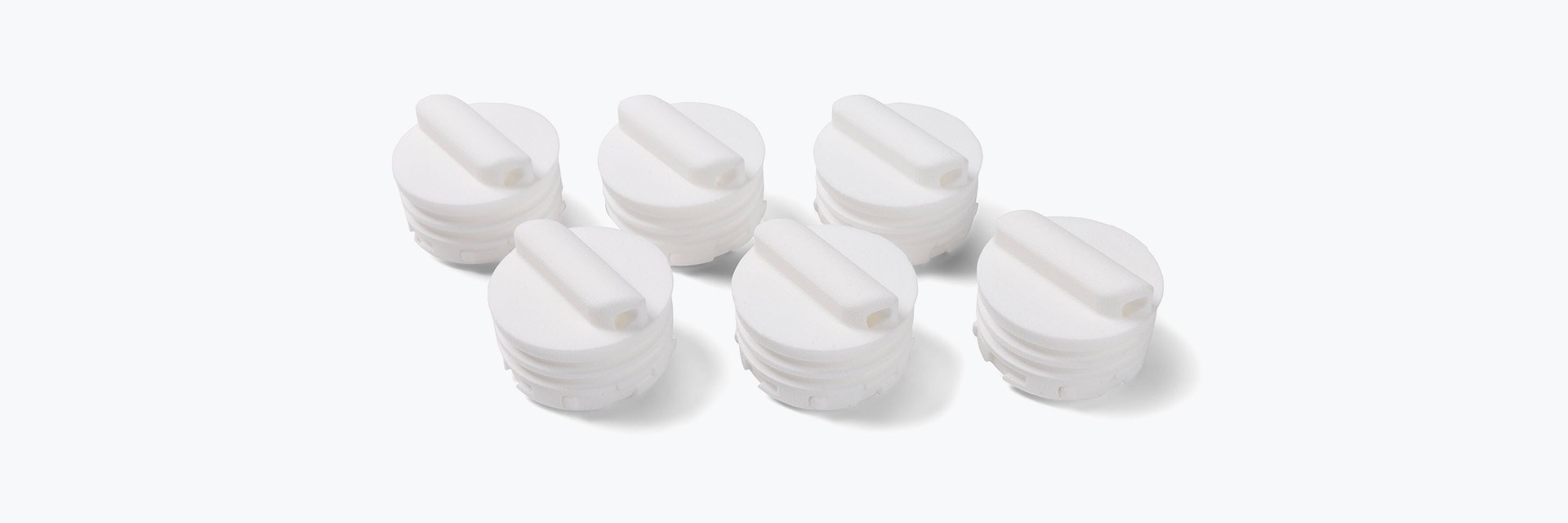CASE STUDY
Why Sartorius Chooses Additive Manufacturing to Deliver Biocompatible Components

Discover how certified manufacturing at Materialise helps Sartorius deliver biocompatible and traceable parts to the highly regulated medtech industry.
The challenge
Produce small series of biocompatible single-use components used in pharmaceutical production.
For more than 150 years, Sartorius AG has provided equipment to the biopharmaceutical sector. In that time, their offering has shifted from measuring scales to high-end bioreactors and other devices, consumables, and services necessary for the production of biologics.
“Biologics are things like vaccines, large molecules that are not conventionally produced via chemical reactions,” explains Lukas Raddatz, Manager of Additive Manufacturing Innovation and Implementation at Sartorius. "Aspirin, for example, is a chemically produced compound in the tablets. But our customers use biological compounds, such as cells or enzymes, to produce medicine.”
This classification makes biocompatibility an essential feature of every component Sartorius produces — something that many additive manufacturing materials can claim to be. The issue, however, is in defining exactly what that means. For Sartorius, their understanding of the term is often very different from that of suppliers.
“Suppliers will tell us about a great material — it’s food safe and biocompatible. But when we ask them what makes it that way, the answer is often that it has an antibacterial agent,” says Jeremy Pullin, Head of Additive Manufacturing at Sartorius. “And that’s great for some applications, but it’s not really going to work in a bioreactor where you’re growing bacteria broths worth hundreds of thousands of pounds. There are often holes in the knowledge behind these certifications that we absolutely have to fill ourselves.”


Understandably, this makes industry regulations incredibly strict. Materials, suppliers, and production processes are all subject to stringent testing before adoption, especially for the single-use parts that Materialise produces. Meeting the key requirements of biocompatibility and traceability is essential.
It's this dedication to doing so that has earned Sartorius so much respect in the industry. Today, they count some of the largest pharmaceutical companies in the world among their list of customers. With this reputation comes responsibility. As Jeremy puts it, “When medicines go wrong, they don’t just pull over to the hard shoulder like a broken down car. The consequences are much more serious.”


The solution
Certified additive manufacturing using PA 12.
Choosing additive manufacturing
“The world of biotech is definitely late to the party in terms of AM compared to the likes of aerospace and automotive,” says Jeremy. “But from a challenge point of view, in terms of scale and regulatory requirements, they’re definitely on par.”
However, the difficulty in bringing AM to this particular field of medtech has little to do with the capabilities of the technology itself. The understandable dedication to safety and repeatability has made implementing change a slow process.
“Generally speaking, the biopharmaceutical industry tends to have stringent regulations due to the involvement of approval agencies such as the FDA or EMA. These agencies not only evaluate the safety and efficacy of the end product but also closely scrutinize the entire production process and changes made to it,” explains Lukas. “That's why introducing new materials or manufacturing strategies is time-consuming.”
As such, the decision to use additive manufacturing wasn't taken lightly. Sartorius’ Additive Manufacturing Group saw to that. Founded in 2017, the AM group coexists with other departments dedicated to technologies such as injection molding, offering advice on when and how to use AM to its fullest.
“We only apply AM when and where it makes sense, never just for the sake of it,” says Lukas. “This puts us in a position where people know that we recommend what’s best for the product and project, and in the long run, the customer and the patient.”
Jeremy quickly agrees.
“As a technology-agnostic company, we will always evaluate the options against each other. One of the biggest reasons to choose AM is time. Right now, we’re approaching a product launch, for example, and we need to develop a part quicker than would be possible with traditional technologies.
“The other most common driver is added value — where can AM add value? In the case of one of our parts, the spectroscopy port, there was a particularly challenging geometry in there. And it was a really good fit because of the actual function of the part and the geometry required to fulfill that function."


A carefully controlled process
Given the nature of their industry, the Sartorius team requires parts and processes to comply with standards such as ISO 9001. After auditing the facility and meeting the team, Sartorius was satisfied that Materialise’s certified manufacturing process guarantees that these demands are met and that the results are repeatable. Every part they source from Materialise is made by following this strict process, ensuring every step is traceable.
But that’s just the beginning. For Jeremy and his team, it was important to look beyond the numbers.
“Of course, our industry demands levels of traceability and to know that every step of the process is controlled, every step is certified. But for us, it’s not just about the numbers on the standards; it’s about the environment, the cleanliness of the facility, and the attitude,” he explains. “For example, how complaints are handled. Some suppliers will just say, ‘Well, that’s how it comes out of the machine,’ whereas Materialise will say, ‘Oh, that doesn't work for you. What can we do to improve it?’”
Choosing PA 12
Similar restrictions are applied to the materials they can use for any part they print; every choice will depend on the part's application and the requirements stemming from that. This decision is made following a stringent validation process that Jeremy and his team take into their own hands. After all, the consequences of using the wrong material can be severe and incredibly expensive.
In this case, the decision was made to produce most of Sartorius’ single-use components in PA 12. While it is one of the most popular materials in standard 3D printing applications, selecting it here was far from a foregone conclusion.
“At Sartorius, we have strict guidelines that tell us what, how, and when to test for which application. We aim to generally proof materials for applications within the company, allowing us to have a portfolio of materials in the future that we know can be used for specific purposes,” explains Lukas.
“A second aspect that we consider, besides biocompatibility, is extractables and leachables. These are small chemical compounds that can enter the liquid by being leeched out of a material. The guidelines here are a bit more complex — it’s not a yes/no or a traffic light system. Having a sound understanding of the material and its chemistry with the molecules is crucial to us.”
“Our production developers and AM designer lead the design of our single-use components, but we receive a lot of very valuable input from the process engineers and project managers at Materialise that is taken onboard and fed back into our design processes.”
— Tim Gabbitas, Additive Manufacturing Specialist at Sartorius
The result
Over 26,000 truly biocompatible parts printed to date, used by some of the leading names in pharmaceuticals.
“Our production developers and AM designer lead the design of our single-use components, but we receive a lot of very valuable input from the process engineers and project managers at Materialise that is taken onboard and fed back into our design processes,” explains Tim Gabbitas, Additive Manufacturing Specialist at Sartorius. “Especially during the qualification process and when moving into certified manufacturing, when we have conversations about things like cleanability and tolerances.”
Since 2018, Materialise and Sartorius have worked together to produce over 26,000 single-use end-use components that are trusted by some of the most well-known names in the industry. The mRNA COVID vaccines, for example, were produced and finished using Sartorius devices. Choosing AM helped speed up production, remove the need for assembly, and ensure that the complicated geometries of certain parts were replicated in the end product.
It’s an ongoing relationship where trust and dialogue are key.
“In a highly regulated organization like ours, we have to have a good relationship with our suppliers. We have to do the vendor QA audits and ensure they’re compatible with our QMS, so you don’t want a big range of suppliers,” says Jeremy. “The breadth of processes that Materialise offers, along with the credibility and experience within the industry that only comes over time, is a big draw to us.”
“When we have to industrialize products, the relationship has been very productive. Our quality team can go to Leuven and touch base with yours — we'll tell you what we need, and you'll show us what you can do to make sure we get it,” he continues. “It’s been very much a conversation, whereas other suppliers will only work their way or not at all. That’s what really makes Materialise stand out.”
You can learn more about Sartorius and their equipment on their official site.
Share on:
This case study in a few words
Medtech
Certified additive manufacturing
- Short series manufacturing
- Fast design iterations
- Complex designs
- Reduction of assembly time/cost
